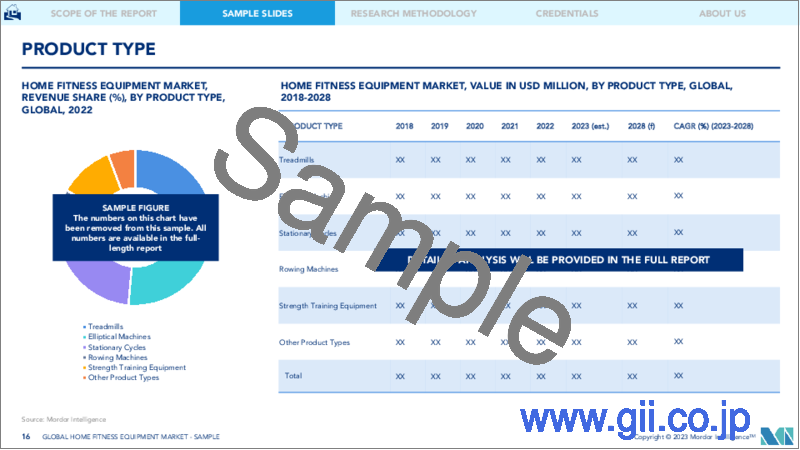|
|
市場調査レポート
商品コード
1197170
家庭用フィットネス機器市場の成長、動向、予測(2023年~2028年)Home Fitness Equipment Market - Growth, Trends, and Forecasts (2023 - 2028) |
||||||
|
● お客様のご希望に応じて、既存データの加工や未掲載情報(例:国別セグメント)の追加などの対応が可能です。 詳細はお問い合わせください。 |
|||||||
| 家庭用フィットネス機器市場の成長、動向、予測(2023年~2028年) |
|
出版日: 2023年01月23日
発行: Mordor Intelligence
ページ情報: 英文 145 Pages
納期: 2~3営業日
|
- 全表示
- 概要
- 目次
家庭用フィットネス機器の市場規模は、前年、137億4,123万米ドルとなり、予測期間中のCAGRは2.75%と予測されています。
短期的には、予防医療に加え、ワークアウトのタイミングを含めカスタマイズされたワークアウトレジームや家庭での快適な環境を好む顧客が増加し、毎日運動することに熱心な家庭用フィットネス機器の需要が高まっています。また、最近の家庭用フィットネス機器の成長は、主に発展途上国において、マシンを使用するためにジムへ通うこと、トレーナー料、会費がかかることが不便であることに起因しています。また、マッサージチェア、エクササイズバイク、エクササイズ用トレッドミル、クロスなどのバルクフィットネス機器を中心としたスペースの制約が、家庭用フィットネス機器市場の成長を阻む大きな要因となっています。このため、新興のスポーツジムやフィットネスセンター、ヘルスクラブが世界的に活性化しています。
また、誰もが設備の整ったジムを持てるわけではありませんが、小規模なトレーニング機器には様々な可能性があります。その結果、Temple Studioのような企業が、ミニ冷蔵庫サイズのオールインワン・ホームジムを400ドル弱で提供しています。さらに、スマートフォンの普及に伴い、市場参加者はモバイルアプリケーションやウェブサイトを通じてサービスを管理するオプションを顧客に提供しています。eヘルス・プラットフォームは、ビデオ・オン・デマンド、ライブ・リモート・トレーニング、独自のワークアウト・プログラムの作成、その他、自分で操作して専門家の指導を受けられるサービスを提供しています。eヘルスプラットフォームのこれらの関連する利点は、働いていて忙しい顧客の間で巨大な需要を生み出しており、それは将来的に動向であり続けると予想されます。このように、eヘルスプラットフォーム、スポーツジム、フィットネスセンターのコンサルティングサービスなどが、健康器具市場を牽引していくと予想されます。
家庭用フィットネス機器の市場動向
消費者の健康意識の高まり
消費者は、デジタル接続されたフィットネス機器の利点を活用し、オンライン・ワークアウト・クラスを通じて、個人に合ったトレーニング体験を楽しんでいます。デジタル・セルフケア・プラットフォームは、より安全で健康的な未来のための重要なビルディング・ブロックとなっています。COVID-19の大流行の中、人々は室内で過ごす時間が長くなり、身体を動かすことは身体的健康にも精神的健康にも重要です。フィットネスクラブの日課から離れることは、いつもジムに通っている人にとって不便なことでした。Eヘルスやフィットネス・プラットフォームは、人々が健康で元気でいるための重要なツールとなっています。したがって、パンデミックは、家庭用フィットネス機器市場は、人々のジミングやワークアウトの習慣の変化のためにさらに浸透を助けました。今年、Nike Training Club、TREAD、Adidas Training by Runtastic、HealthifyMe、Daily Yogaなどのオンラインフィットネスプラットフォームが、ユーザーにジムのような体験を提供し、体力づくりやヘルスクラブにマイナスの影響を及ぼしているのです。
家庭用フィットネス機器は、マシンを使用するためにジムに通う不便さを解消し、長い目で見れば高い費用対効果を発揮します。結局、このセグメントでは、ボディービルなどユーザー特有のカスタマイズされたフィットネス要件を満たすために、オンラインクラスまたは自宅訪問のどちらかのトレーナーを顧客が選択するためのプラットフォームを提供するアプリを立ち上げるなど、数多くのイノベーションが起こりました。さらに、消費者の健康に対する意識の高まりから、この種の機器の需要も増加しています。
家庭用フィットネス機器市場を牽引する北米市場
北米では、消費者の健康意識の高まりと、健康維持・増進、体重管理、スタミナ・筋力向上に関連したエクササイズの普及が進み、市場は大きく拡大しています。また、肥満人口の増加や健康志向の高まりも、同地域の家庭用フィットネス機器市場を牽引する主な要因となっています。予防医療の高まりと医療費の増大により、消費者は健康を維持するために定期的な運動を行うようになっています。需要の拡大に伴い、世界市場で事業を展開するメーカー各社は、競争優位性を確保するためにその存在感を高めています。また、家庭内での運動に対する消費者の関心が高まっていることから、こうした家庭用機器の需要も拡大しており、これも家庭用機器市場を牽引しています。
家庭用フィットネス機器市場の競合他社分析
今回調査した市場は、競合が多いのが特徴です。これは、この分野には国内外に複数のプレーヤーが存在するためです。このそれぞれの分野における主要なプレーヤーは、Nautilus Inc.、Icon Health &Fitness Inc.、Johnson Health Tech、Technogym SpA、Peloton Interactive Inc.であります。これらのトップ企業が採用する主な戦略は、消費者に新しい製品を提供することを可能にする製品革新と新製品開発です。同じセグメントの他のプレイヤーのいくつかは、これらのトッププレイヤーが他の国内プレイヤーに対して支配的な地位を獲得するのに役立ちますので、彼らの主要な戦略として合併や買収を選ぶ。この特定の戦略はまた、これらのプレイヤーが他の競合企業間の競争と競合の進行中の連鎖を断ち切ることができます。
その他の特典
- エクセル形式の市場予測(ME)シート
- アナリストによる3ヶ月間のサポート
目次
第1章 イントロダクション
- 調査の前提条件と市場の定義
- 調査対象範囲
第2章 調査手法
第3章 エグゼクティブサマリー
第4章 市場力学
- 市場促進要因
- 市場抑制要因
- ポーターのファイブフォース分析
- 新規参入業者の脅威
- 買い手/消費者の交渉力
- 供給企業の交渉力
- 代替品の脅威
- 競争企業間の敵対関係
第5章 市場セグメンテーション
- 製品タイプ別
- トレッドミル
- エリプティカルマシン
- ステーショナリーサイクル
- ローイングマシン
- ストレングストレーニング機器
- その他の製品タイプ
- 販売チャネル別
- オフライン店舗
- オンラインショップ
- 直販
- 地域別内訳
- 北米
- 米国
- カナダ
- メキシコ
- その他北米地域
- 欧州
- 英国
- ドイツ
- スペイン
- フランス
- イタリア
- ロシア
- その他の欧州地域
- アジア太平洋地域
- 中国
- 日本
- インド
- オーストラリア
- その他アジア太平洋地域
- 南米
- ブラジル
- アルゼンチン
- その他の南米地域
- 中東
- 南アフリカ共和国
- アラブ首長国連邦
- その他の中東地域
- 北米
第6章 競合情勢
- 最も採用されている戦略
- 市場シェア分析
- 企業プロファイル
- Anta International Limited(Amer Sports Oyj)
- Nautilus Inc.
- Johnson Health Tech Co. Ltd
- Origin Fitness Ltd(Anytime Leisure Limited)
- Dyaco International Inc.
- Technogym SpA
- Peloton Interactive Inc.
- TRUE Fitness
- Icon Health & Fitness Inc.
- Decathlon SA
第7章 市場機会と将来動向
第8章 COVID-19が市場に与える影響
The home fitness equipment market was valued at USD 13,741.23 million in the previous year and is projected to register a CAGR of 2.75% during the forecast period.
Over the short term, precautionary healthcare, coupled with an increasing preference for customized workout regimes (including workout timing) and a comfortable home-friendly environment, is increasing the demand for home fitness equipment as customers are keen to exercise daily. Growth in home fitness equipment in the recent past was also the result of the inconvenience of commuting to a gym to use the machines, trainer fees, and membership fees, primarily in developing countries. The space limitation, primarily for bulk fitness equipment, such as massage chairs, exercise bikes, exercise treadmills, and cross, is a major factor that limits the growth of the home fitness equipment market. This has stimulated start-up gyms, fitness centers, and health clubs worldwide.
Additionally, while not everyone can afford a fully equipped gym, there are various possibilities for small-scale training equipment. As a result, companies like Temple Studio are now offering an all-in-one home gym the size of a mini-fridge, costing just under USD 400. Furthermore, owing to the increasing popularity of smartphones, market players are offering customers the option of managing their services through mobile applications and websites. The e-health platforms are offering video-on-demand, live remote training, creating their own workout programs, and other offers that are self-operated and guided by experts. These associated benefits of e-health platforms have created huge demand among working and busy customers, and it is expected to remain trending in the future. Thus, e-health platforms, gyms, and fitness center consulting services are expected to drive the health and fitness equipment market.
Home Fitness Equipment Market Trends
Rising Health Awareness Among the Consumers
Consumers are leveraging the benefits of digitally connected fitness equipment to enjoy a personalized training experience through online workout classes. Digital self-care platforms have become a critical building block for a safer and healthier future. Amid the COVID-19 pandemic, people have spent more time indoors, and keeping the body moving is important, both for physical health and mental well-being. Being away from their fitness club routines was inconvenient for regular gym goers. E-health and fitness platforms have been a few important tools to help people keep themselves fit and fine. Hence, the pandemic helped the home fitness equipment market penetrate further due to the change in the gymming and workout habits of people. In the current year, some of the online fitness platforms, such as Nike Training Club, TREAD, Adidas Training by Runtastic, HealthifyMe, and Daily Yoga, are offering a gym-like experience to the user, which is impacting physical fitness and health clubs negatively.
Home fitness equipment eliminates the inconvenience of commuting to a gym to use the machines and is highly cost-effective in the long run. Eventually, numerous innovations have occurred in this segment, such as launching apps that provide a platform for customers to select their trainers for either online classes or home visits, to meet the user's specific and customized fitness requirements, such as bodybuilding. Moreover, due to the rising awareness among consumers regarding their health, the demand for these types of equipment has also increased.
North America Leading the Home Fitness Equipment Market
The North American market witnessed significant growth due to the rising health awareness among consumers and the growing adoption of exercises related to physical well-being, weight management, and improving body stamina and muscular strength. The rising obese population and increasing health concerns are other major factors driving the home fitness equipment market in the region. The rising preventive healthcare measures and the augmenting healthcare costs enable consumers to engage in regular workouts to remain fit. With the growing demand, manufacturers operating in the global market are expanding their presence to achieve a competitive advantage. Moreover, due to the consumer's growing interest in in-home workouts, the demand for such home equipment is growing, which is also driving the home equipment market.
Home Fitness Equipment Market Competitor Analysis
The market studied is competitive in nature. This is due to the existence of several domestic and international players in this segment. The major players in this respective sector are Nautilus Inc., Icon Health & Fitness Inc., Johnson Health Tech Co. Ltd, Technogym SpA, and Peloton Interactive Inc. The key strategy adopted by these top players is product innovation and new product development, as it enables them to offer new products to the consumer. Some of the other players in the same segment opt for mergers and acquisitions as their key strategy, as it helps these top players capture a dominant position over other domestic players. This specific strategy also enables these players to break the ongoing chain of competition and rivalry among the other competitors.
Additional Benefits:
- The market estimate (ME) sheet in Excel format
- 3 months of analyst support
TABLE OF CONTENTS
1 INTRODUCTION
- 1.1 Study Assumptions and Market Definition
- 1.2 Scope of the Study
2 RESEARCH METHODOLOGY
3 EXECUTIVE SUMMARY
4 MARKET DYNAMICS
- 4.1 Market Drivers
- 4.2 Market Restraints
- 4.3 Porter's Five Forces Analysis
- 4.3.1 Threat of New Entrants
- 4.3.2 Bargaining Power of Buyers/Consumers
- 4.3.3 Bargaining Power of Suppliers
- 4.3.4 Threat of Substitute Products
- 4.3.5 Intensity of Competitive Rivalry
5 MARKET SEGMENTATION
- 5.1 By Product Type
- 5.1.1 Treadmills
- 5.1.2 Elliptical Machines
- 5.1.3 Stationary Cycles
- 5.1.4 Rowing Machines
- 5.1.5 Strength Training Equipment
- 5.1.6 Other Product Types
- 5.2 By Distribution Channel
- 5.2.1 Offline Retail Stores
- 5.2.2 Online Retail Stores
- 5.2.3 Direct Selling
- 5.3 By Geography
- 5.3.1 North America
- 5.3.1.1 United States
- 5.3.1.2 Canada
- 5.3.1.3 Mexico
- 5.3.1.4 Rest of North America
- 5.3.2 Europe
- 5.3.2.1 United Kingdom
- 5.3.2.2 Germany
- 5.3.2.3 Spain
- 5.3.2.4 France
- 5.3.2.5 Italy
- 5.3.2.6 Russia
- 5.3.2.7 Rest of Europe
- 5.3.3 Asia-Pacific
- 5.3.3.1 China
- 5.3.3.2 Japan
- 5.3.3.3 India
- 5.3.3.4 Australia
- 5.3.3.5 Rest of Asia-Pacific
- 5.3.4 South America
- 5.3.4.1 Brazil
- 5.3.4.2 Argentina
- 5.3.4.3 Rest of South America
- 5.3.5 Middle East
- 5.3.5.1 South Africa
- 5.3.5.2 United Arab Emirates
- 5.3.5.3 Rest of Middle East
- 5.3.1 North America
6 COMPETITIVE LANDSCAPE
- 6.1 Most Adopted Strategies
- 6.2 Market Share Analysis
- 6.3 Company Profiles
- 6.3.1 Anta International Limited (Amer Sports Oyj)
- 6.3.2 Nautilus Inc.
- 6.3.3 Johnson Health Tech Co. Ltd
- 6.3.4 Origin Fitness Ltd (Anytime Leisure Limited)
- 6.3.5 Dyaco International Inc.
- 6.3.6 Technogym SpA
- 6.3.7 Peloton Interactive Inc.
- 6.3.8 TRUE Fitness
- 6.3.9 Icon Health & Fitness Inc.
- 6.3.10 Decathlon SA




